Virunga National park is located in the Eastern part of the Democratic Republic of Congo, close to the border with Rwanda and Uganda. The park is part of what is called the Virunga massif which includes the Volcanoes National Park in Rwanda and the Mgahinga National Park in Uganda. The Virunga massif is known for its rich biodiversity and as one of the oldest wildlife conservation areas in Africa. The Virunga National Park was established in 1925 by the European conservation movement making it the oldest national park in Africa.
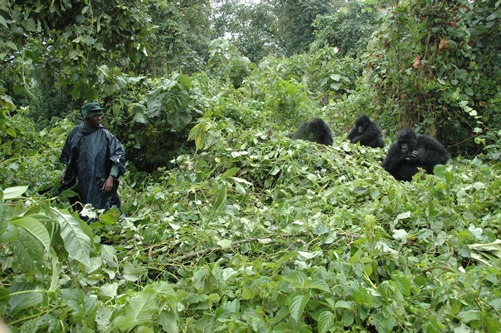 The Virunga national park is home several species of mammals, primates, birds and vegetation- some of which are endemic to the Albertine rift. Among the most popular primates in Virunga national park are the mountain gorillas, chimpanzees, colobus monkeys, red tailed monkey, golden monkeys, Debrazza’s monkeys and Blue monkeys. The park is also home to forest elephants, blue duikers, okapi, buffaloes, topi, the common warthog, forest hogs and the Ugandan kob to mention but a few. Two active volcanoes paint the skies of the Virunga national park, helping define the preface and natural biodiversity in the park. They are Nyiragongo and Nyamuragira. These volcanic mountains have rich soils on the slopes which help forests and other types of vegetation to thrive. Because of the remarkable biodiversity and stunning landscape, the Virunga National Park is now considered a UNESCO World Heritage site.
The Virunga national park is home several species of mammals, primates, birds and vegetation- some of which are endemic to the Albertine rift. Among the most popular primates in Virunga national park are the mountain gorillas, chimpanzees, colobus monkeys, red tailed monkey, golden monkeys, Debrazza’s monkeys and Blue monkeys. The park is also home to forest elephants, blue duikers, okapi, buffaloes, topi, the common warthog, forest hogs and the Ugandan kob to mention but a few. Two active volcanoes paint the skies of the Virunga national park, helping define the preface and natural biodiversity in the park. They are Nyiragongo and Nyamuragira. These volcanic mountains have rich soils on the slopes which help forests and other types of vegetation to thrive. Because of the remarkable biodiversity and stunning landscape, the Virunga National Park is now considered a UNESCO World Heritage site.
Although the Virunga national park is a UNESCO World Heritage site with amazing biodiversity, it has not reached its potential as a tourism destination due to political instability and insecurity ins some parts of the country. Virunga national park has not escaped the impact of rebel activity as they attempt to oust the different governments of the country over the years. There is also encroachment on park resources by communities living close to the park.
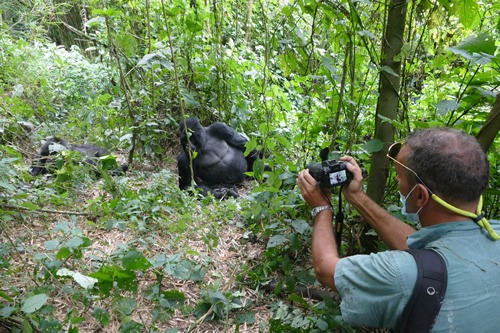 Poaching is also still a problem in the park. With all the poaching and militias still in surrounding areas, Virunga Park is one of the best managed parks in Africa. The park has an international management team and attracts a lot of funding to compensate for the fewer tourists visiting the park at the moment. They have set an amazing Ranger project where hundreds have been recruited to protect the park. The park also set up the amazing Senkwekwe Centre to rehabilitate orphaned gorillas. Poaching and militias in the park have been kept away because of the intense training and deployment of park Rangers. We foresee a great future for Congo and the Virunga National Park as the country becomes more and more stable.
Poaching is also still a problem in the park. With all the poaching and militias still in surrounding areas, Virunga Park is one of the best managed parks in Africa. The park has an international management team and attracts a lot of funding to compensate for the fewer tourists visiting the park at the moment. They have set an amazing Ranger project where hundreds have been recruited to protect the park. The park also set up the amazing Senkwekwe Centre to rehabilitate orphaned gorillas. Poaching and militias in the park have been kept away because of the intense training and deployment of park Rangers. We foresee a great future for Congo and the Virunga National Park as the country becomes more and more stable.
Mountain Gorillas in Virunga National Park
Although Virunga National Park is home to incredible mammals, Mountain gorillas stand out and are the most attractive. The Democratic Republic is lucky to have both Mountain gorillas and Eastern lowland gorillas. Whereas Eastern lowland gorillas love living in the lower ground, mountain gorillas are comfortable in higher altitude areas. They are mostly found on the slopes of Mount Nyiragongo and Nyamuragira. Apart from Virunga National Park, mountain gorillas are also found in the Volcanoes National Park of Rwanda, Mgahinga and Bwindi Impenetrable forest in Uganda. Mountain gorillas are 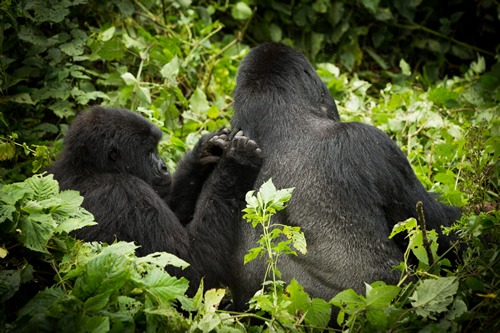 critically endangered species and are listed in the red list of the International Union of Conservation for Nature (IUCN). Only about 1000 remain on earth. Virunga national park has about 300 mountain gorillas and eight groups are habituated.
critically endangered species and are listed in the red list of the International Union of Conservation for Nature (IUCN). Only about 1000 remain on earth. Virunga national park has about 300 mountain gorillas and eight groups are habituated.
Mountain gorillas are the second largest subspecies of gorillas. They have more fur on their bodies because they live in higher altitude. Like all gorilla sub-species, they only feed on plants especially tree branches, shoots, vines and leaves. Mountain gorillas are not territorial. They move from one place to another looking for food and shelter. Although an adult can weigh up to 160 kilograms and look intimidating, mountain gorillas are very peaceful primates. They are also very social primates living in groups of between 6 to 30 individuals.
Gorilla Trekking in Virunga National Park
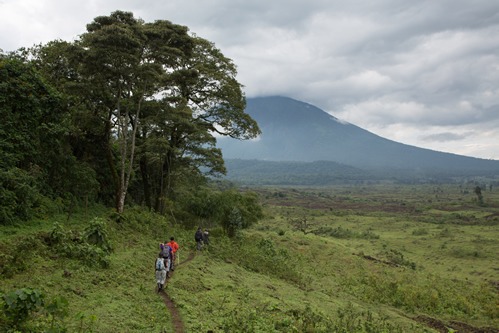 Because of the endangered status of mountain gorillas, the three gorilla countries of Congo, Uganda and Rwanda acted first to protect the primates. Apart from taking control of the parks, it was discovered that promoting gorilla tourism would expose the gorillas to the wider world, attract funding and let the people living close to the parks realize the importance of the primates to the park. Gorilla trekking in Virunga National Park brings in thousands of tourist each year and is one of the top activities while on a safari in Congo. It helps raise the money required to maintain the park, promote gorilla conservation activities and community outreach programs.
Because of the endangered status of mountain gorillas, the three gorilla countries of Congo, Uganda and Rwanda acted first to protect the primates. Apart from taking control of the parks, it was discovered that promoting gorilla tourism would expose the gorillas to the wider world, attract funding and let the people living close to the parks realize the importance of the primates to the park. Gorilla trekking in Virunga National Park brings in thousands of tourist each year and is one of the top activities while on a safari in Congo. It helps raise the money required to maintain the park, promote gorilla conservation activities and community outreach programs.
Gorilla permits in Congo cost $450 and gorilla trekking starts very early in the morning. Those with permits gather at the park headquarters for briefing about the park and the gorilla groups that are open to tourism. After the briefing, the Rangers lead tourists to track a specific gorilla family. Only 8 people may track a gorilla group in day. The activity takes between 2 to 6 hours but tourists are allowed only one hour with the primates. During the one hour, tourists can observe the gorillas feed, play around, 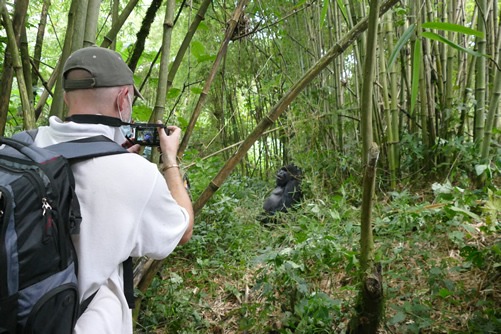 mate, breast feed, groom and communicate among themselves. The gorilla way of communicating is intriguing but tourists should not attempt to mimic them to avoid attracting unnecessary attention. The one hour allows everyone time to take a good photo of them among the primates to show their friends back home. Please check out our 2 days Congo gorilla tour package.
mate, breast feed, groom and communicate among themselves. The gorilla way of communicating is intriguing but tourists should not attempt to mimic them to avoid attracting unnecessary attention. The one hour allows everyone time to take a good photo of them among the primates to show their friends back home. Please check out our 2 days Congo gorilla tour package.
What are the chances of seeing mountain gorillas? As long as you don’t give up after one hour or so, the chances of seeing gorillas in Virunga National Park is 100%. The park rangers are very experienced and know how to track the gorillas up to their most recent location regardless of whether they move or not. The park rangers follow the foot prints and dung as a clue to where they are feeding from. You may also be interested in information about gorilla trekking in Mgahinga National Park.
What you need to know about gorilla trekking in Virunga National Park
In order to plan for the best gorilla trekking experience in Virunga National Park, one needs to prepare well before showing up at the park. There is also some information that you might find useful and aid your preparation as you travel to a foreign country. Here are some things to take into consideration while planning to do gorilla trekking in Virunga National Park:
You need to prepared to deal with the physical challenges involved in gorilla trekking. Gorilla trekking involves going though unpredictable terrain. You may need to hike through valleys, hills and even cross streams to get to the gorilla group. Ensure that you are fit enough to walk for long distances by doing 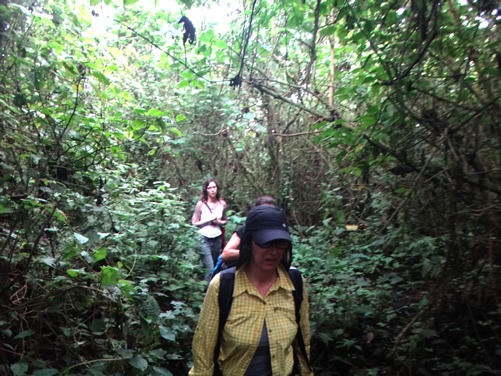 some hiking exercises before showing up for gorilla trekking. Whereas physical preparedness is important, even more important is the mental preparedness and the strong desire to complete the trek.
some hiking exercises before showing up for gorilla trekking. Whereas physical preparedness is important, even more important is the mental preparedness and the strong desire to complete the trek.
Before going into the jungles to look for the gorillas, ensure that you have the right clothing and footwear. Your clothing should be able to protect you from rain, sharp tree branches and insects. Ensure that you have good hiking boots with good traction. Hand gloves will protect your hands from sharp tree branches. Apart from clothing, you need not forget to carry important tools like a good camera, sun glasses, insect repellents, a hat/cap, drinking water and snacks.
If you are planning to travel with heavy luggage or cameras, we recommend that you hire a porter while going out into the forest. It is very inconveniencing to carry heavy luggage for long hours in your back. To avoid getting tired and concentrating only on gorilla trekking, we advise that you hire a porter at the starting point. Porters hire their services for between 10 to 15 US Dollars.
Which is the best season for gorilla trekking in Virunga National Park? The dry season is regarded as the perfect time to track the gorillas. This is the time when the trails in the forests are easier to follow and 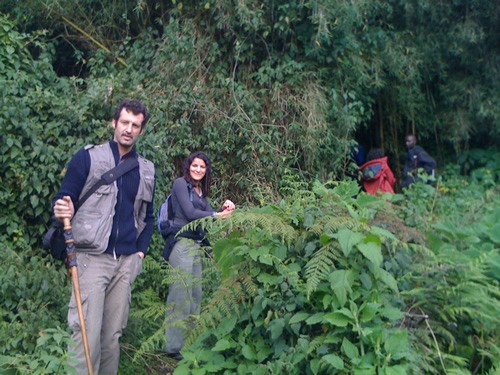 there is less mud. In the wet season, the trails are slippery and more difficult to hike through. The wet season has its advantages because there are less trackers and you can have a more private tour. The choice on when to go out tracking depends entirely on you.
there is less mud. In the wet season, the trails are slippery and more difficult to hike through. The wet season has its advantages because there are less trackers and you can have a more private tour. The choice on when to go out tracking depends entirely on you.
Book with a reputable local tour operator. A good tour operator ensures that his/her client gets the best services – good vehicles, accommodation services and gorilla permits booked on time. A reliable tour operator relieves you of having to figure out and do all the planning work by yourself. All you need to do is how up.
Book your gorilla trekking safari in advance with your tour operator so that gorilla permits are reserved on time. There is a high demand for gorilla permits and you cannot be sure of getting one on a specific day. If you choose a tracking date weeks before the tour, you might find that there are no spots available on the day you intend on showing up. The tour operator should also ensure that your accommodation is booked in advance. There are few high quality hotels in the area. The best ones are owned by Virunga National Park.
As a foreign travel, it’s important to always move with your travel documents. Crossing the Congo border and getting a Congo Visa is more controlled. In fact, it is your tour operator to help you process your Visa in most cases. If you choose to apply for the Visa yourself, expect longer delays in approval. The Congo Visa costs $100 but you also need to show you passport and Yellow fever vaccination card before entering into the country.
Getting to Virunga National Park
Due to the insecurity in certain parts of Congo and being a very large country, it is more practical to arrive through Uganda or Rwanda before crossing the border to Congo and to the Virunga National Park. Let’s discuss the two routes in more detail: –
Rwanda – Congo route: This route involves arriving though Kigali international airport. To arrive in Rwanda, you can book Fly Emirates, Qatar Airways, KLM, British Airways, South Africa Airways, Ethiopian Airlines or Rwanda air. All these air carriers have flights that can bring you from your country to Rwanda. Once you touch down in Kigali, you will be received by a safari guide from your tour operator. The Guide will take you for rest in a hotel in Kigali if you arrive late. Should you arrive early, the driver takes you straight to Gisenyi in Rwanda in a journey that takes 4 hours. Gisenyi is a town found close to the border with Congo. If you have planned your tour without needing a tour operator, you can opt to use public buses plying the Kigali to Gisenyi route. It’s cheaper but less convenient considering that you will have frequent stopovers. Once you reach the border crossing, you should find your visa already in the system and you will do is hand in your passport for stamping. A yellow fever vaccination card is a must while crossing the Congo Rwanda border. Once all documents are shown, the Guide from your tour company will hand you over to the Virunga foundation. The Virunga Foundation manages the park and is responsible for organizing all tourism activities. They are also responsible for transportation, accommodation and gorilla trekking experience while at the park. The foundation normally sells the gorilla trekking experience as a full tour package including the gorilla permits, meals, transport and accommodation to the tour operators.
Note: It is important to note that a traveler will be required to acquire another Visa while entering back into Rwanda after completing gorilla trekking in Virunga National Park. Travelers can also access Goma by boat from the Rwandan side of Lake Kivu. You would still need to get a car from Kigali to Lake Kivu. The prices for boats cost between 300$ and 400$.
Uganda – Congo route: The Uganda route generally longer and we only recommend it for travelers who are already in Kisoro, Kabale or the western part of the country. If you choose to arrive through Entebbe International airport, you will have to endure a journey over 8 hours. Entering Congo would be through the Bunagana border. The process of crossing the Congo border through the Bunagana border is similar to that used in Gisenyi.
The cost of gorilla trekking in Virunga National Park
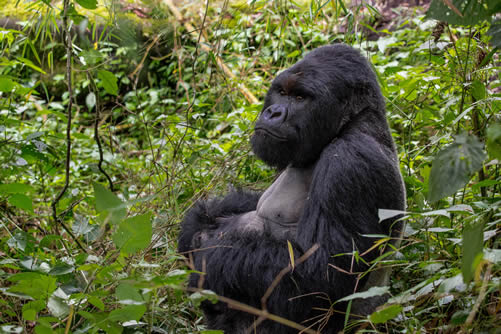 What is the cost of gorilla trekking in Virunga National Park? Virunga national park is the cheapest gorilla destination. A gorilla permit goes for $450. This may appear expensive until you compare it with the $1500 charged in Rwanda and the $700 in Uganda. The gorilla permit only grants you access to the park and to the primates. You also need to take into consideration the cost of transportation, accommodation, meals, air tickets, tips, Visa and expenses on souvenirs. The cost of gorilla trekking in Congo also depends on whether you are traveling on budget, mid-range or luxury tour.
What is the cost of gorilla trekking in Virunga National Park? Virunga national park is the cheapest gorilla destination. A gorilla permit goes for $450. This may appear expensive until you compare it with the $1500 charged in Rwanda and the $700 in Uganda. The gorilla permit only grants you access to the park and to the primates. You also need to take into consideration the cost of transportation, accommodation, meals, air tickets, tips, Visa and expenses on souvenirs. The cost of gorilla trekking in Congo also depends on whether you are traveling on budget, mid-range or luxury tour.
Accommodation for gorilla trekking in Virunga National Park
The accommodation facilities within Virunga National Park and in Goma town are built to cater for three categories of travelers – Those traveling on budget, midrange traveler and the luxury client. The budget lodges are less costly and offer average bedding and services. They are self-contained good bedding, moderate toilets and bathrooms. The food and beverages are also basic. Most offer room service, television screens, swimming pools and even airport transfers. However, these services are not of very high quality and it is not a guarantee that you will receive them. Even if you find all the services, you might sense a lack of attention to detail. Most budget lodges and hotels charge less than $100 per night
The middle class accommodation facilities take quality to the next level and charge moderate prices ranging from $100 to $250. Their services and facilities are not average. The rooms are always self-contained with a reading desk, telephone services, a bar and restaurant. Both local and continental dishes are served. Finally, there are the luxury accommodations. These offer the highest possible quality and target clients who want to best possible experience while away from their luxury homes. Everything in a luxury room is perfect. The rooms are spacious rooms with a balcony, laundry services, an exquisite bar, a restaurant, a conference room, airport transfer, a large swimming pool, a gym, large gardens, spa and massage. Luxury hotel are always built in great locations with beautiful views of the park.
Having discussed the differences between the various accommodation facilities in Virunga, lets now look at some of the hotels are lodges available: –
 Kibumba tented camp: Kibumba is a mid-range lodge found within the Virunga National Park and close to the border with Rwanda. It is built at the foot of the great Nyiragongo Volcano hence offering amazing views of the park. Most tourists who stay here are those who are combing gorilla trekking with hiking the Nyiragongo Volcano. The facility is not that expensive when compared to other mid-range lodges around Virunga national park. In fact, their services are similar to some of the luxury lodges. The 18 tented camps have comfortable beds, exclusive bathrooms, clean toilet, great food and a fully stocked bar. Kibumba tented camp can accommodate 36 guests in a day and is owned by the Virunga Foundation
Kibumba tented camp: Kibumba is a mid-range lodge found within the Virunga National Park and close to the border with Rwanda. It is built at the foot of the great Nyiragongo Volcano hence offering amazing views of the park. Most tourists who stay here are those who are combing gorilla trekking with hiking the Nyiragongo Volcano. The facility is not that expensive when compared to other mid-range lodges around Virunga national park. In fact, their services are similar to some of the luxury lodges. The 18 tented camps have comfortable beds, exclusive bathrooms, clean toilet, great food and a fully stocked bar. Kibumba tented camp can accommodate 36 guests in a day and is owned by the Virunga Foundation
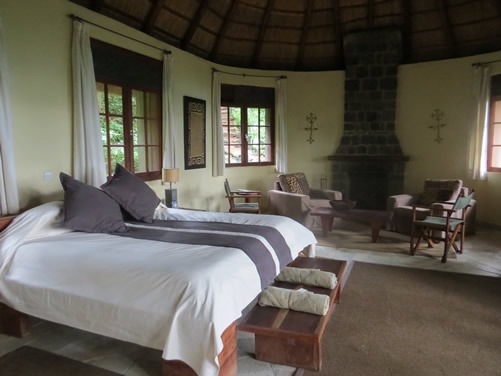 Mikeno Lodge: This luxury was the first accommodation facility opened for tourists who wished to stay within the Virunga national park. It is located in the forests of Rumagambo hence a perfect base for gorilla trekking in Virunga National Park. The lodge has 12 luxury chalets that are constructed with volcanic rocks and with thatched roofs. The rooms are very spacious with their own washrooms and reading desks. The lodge also has a bar and restaurant offering international dishes. Mikeno lodge is a true luxury lodge and the best within Virunga or the surrounding area. It is also run by the Virunga foundation and offers guests a change to visit the Senkwekwe Gorilla orphanage at no cost after gorilla trekking.
Mikeno Lodge: This luxury was the first accommodation facility opened for tourists who wished to stay within the Virunga national park. It is located in the forests of Rumagambo hence a perfect base for gorilla trekking in Virunga National Park. The lodge has 12 luxury chalets that are constructed with volcanic rocks and with thatched roofs. The rooms are very spacious with their own washrooms and reading desks. The lodge also has a bar and restaurant offering international dishes. Mikeno lodge is a true luxury lodge and the best within Virunga or the surrounding area. It is also run by the Virunga foundation and offers guests a change to visit the Senkwekwe Gorilla orphanage at no cost after gorilla trekking.
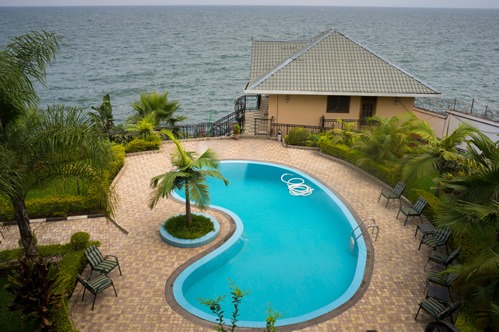 Lac Kivu Lodge: Lac Kivu is a luxury lodge located on the shores of Lake Kivu in Goma. Most of the rooms are built overlooking the beautiful lake hence offering guests beautiful scenery. The lodge has 20 self-contained rooms designed in African style but with modern furniture. All the rooms have free Wi-Fi and a reading desk. The lodge has an amazing garden that attracts birds and small primates. There is also a swimming pool within its premises. Food is excellent and the coffee made is second to none in the area. Lac Kivu Lodge also has an annex with a guesthouse offering standard rooms for mid-range travelers.
Lac Kivu Lodge: Lac Kivu is a luxury lodge located on the shores of Lake Kivu in Goma. Most of the rooms are built overlooking the beautiful lake hence offering guests beautiful scenery. The lodge has 20 self-contained rooms designed in African style but with modern furniture. All the rooms have free Wi-Fi and a reading desk. The lodge has an amazing garden that attracts birds and small primates. There is also a swimming pool within its premises. Food is excellent and the coffee made is second to none in the area. Lac Kivu Lodge also has an annex with a guesthouse offering standard rooms for mid-range travelers.


